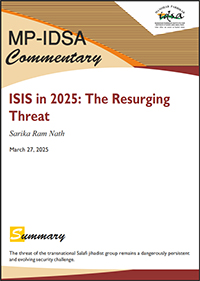ISIS in 2025: The Resurging Threat
- March 27, 2025 |
- IDSA Comments
Introduction
The threat posed by the Islamic State of Iraq and Syria (ISIS) continues to grow as the Global Terrorism Index (GTI) 2025 has reported that the terror conglomerate has expanded its operations now to 22 countries, causing 1,805 deaths in 2024, with Syria and the Democratic Republic of Congo accounting for 71 per cent of its attacks last year.[1] A 2024 UN report estimated that ISIS, despite recent setbacks, still commanded up to 6,000 fighters in Afghanistan, about 3,000 fighters in Syria and Iraq, and 2,000 to 3,000 fighters in the West African states of Mali, Burkina Faso and the Niger.[2]
ISIS’ Strikes on US and Russia
With its deadly strikes at the Crocus City Hall concert venue in Moscow in 2024, which took 133 lives and left over a hundred injured,[3] and its deadly 2005 New Year Eve terror strikes in Las Vegas and New Orleans that killed 15 people and left 57 injured,[4] ISIS has demonstrated its ability to penetrate and strike inside the US and Russia, two countries with arguably the most powerful security forces in the world.
With 1,805 deaths in 2023 alone, ISIS remains a potent terrorist threat with several European countries reporting that one in five terror suspects held under the age of 18 in the continent were mostly linked to ISIS.[5] Another study showed that out of the 58 suspects linked to 27 ISIS-linked attacks or disrupted plots between October 2023 and August 2024, a total of 38 were aged between 13 and 19 years of age.[6]
In this respect, famous pop singer Taylor Swift’s Eras Tour shows were cancelled in Vienna in August 2024, after a 19 year old Austrian citizen was arrested for having plotted a terrorist attack at one of her concerts, following his online allegiance to ISIS operatives outside the country.[7]
ISIS Eyeing US, French Withdrawal from Syria, Africa
Meanwhile, writing for the Institute Study of War in February 2025, Brian Carter stated that a prospective US troop withdrawal from Syria this year would “risk reversing hard-earned gains against the Islamic State of Iraq and al-Sham (ISIS)”.[8] Citing the US Central Command warning of July 2024, Carter stated that ISIS was gradually growing and trying to reconstitute its forces in the region. US experts warn that ISIS has the ability to re-emerge as a potent terrorist threat within a year or two without US presence in Syria.[9] This is despite the killing in an airstrike of ISIS’ ‘foreign operations’ leader, Abdallah Maki Mosleh al-Rufayi in March 2025, according to Iraqi Prime Minister Mohammed Shia al-Sudani.[10]
Meanwhile, Kurdish forces guarding ISIS fighters at a jail in northern Syria have opposed handing over the facility to the Hayat-Tahrir Al Sham-led new government in Damascus. They have persistently called upon Washington to retain the presence of their troops in the country, despite the Trump administration’s plans to withdraw forces from Syria.
The US-backed Syrian Democratic Forces (SDF), a Kurdish-led force warns that ISIS has already attempted two attacks on prisons, in the city of Hasakah, in an attempt to free ISIS inmates from these jails, since Al-Assad’s regime was toppled in Damascus on 8 December 2024.[11] It is estimated that over 4,500 ISIS fighters, including many foreigners, are currently incarcerated in these prisons and Kurdish officials fear that with the coming of the HTS to power, ISIS sympathisers would seek to attack the prisons again.[12]
Meanwhile, Paris has started withdrawal of its military forces from several West African states from 2022 onwards, following decades of its military presence in the continent, with Burkina Faso, Mali, Niger, Chad, Senegal and Ivory Coast cancelling their defence agreements with France.[13]
These agreements were terminated mainly in view of growing opposition to France’s alleged attempt at its “neo-colonial inclinations” in the garb of fighting Islamist forces in the Sahel region. Some Western counter-terrorism experts fear that the exit of French forces from the region would encourage ISIS to increase its activities. In fact, the non-profit data collection organisation named Armed Conflict and Location Event Data (ACLED) claims that ISIS is already the region’s “most violent and active armed actors”.[14]
Although in east Africa, the presence of ISIS comes second to that of Al-Shabaab, an Al-Qaeda affiliate, yet the think tank Crisis Group believes that the chief of ISIS in West Africa, Abdulqadir Mumin, might soon become a major figure in the group’s global leadership, as the affiliate has emerged as a key logistical and financial hub for ISIS’ African and global network.[15]
Conclusion
The Islamic State affiliate group, Islamic State-Khorasan province (IS-K or IS-KP) has been consolidating its presence in Afghanistan, conducting attacks against Taliban forces and ethnic and religious Afghan minorities, as well as in far-off states of Central Asia and Europe.[16] In 2025, the UN warned that ISIS “represented the most serious threat to the de facto authorities (the Taliban regime), ethnic and religious minorities” in Afghanistan.[17]
Meanwhile, ISIS sympathizer Hizbut Tahreer has been radicalising Bangladeshi students, studying in some of the most prestigious schools in Dhaka, who were seen marching with black flags resembling those of ISIS, demanding the establishment of a caliphate, following the anti-Hasina protests last year.[18]
It is also noteworthy that Maldives, another Muslim-dominated country in South Asia, has had the dubious distinction of contributing the highest foreign fighters per capita to Syria and Iraq who went on to fight for ISIS. In July 2023, the US Department of the Treasury’s Office of Foreign Assets Control (OFAC) designated 20 leaders and financial facilitators of the ISIS and al-Qa’ida in Maldives as terrorists.[19]
It is also noteworthy that according to a UN report, ISIS core leadership sends funds to Tahreek-e-Taliban Pakistan (TTP) to “outsource” attacks due to its depleted manpower.[20] According to the GTI report of 2025, Tehrik-e-Taliban has emerged as the world’s fastest-growing terrorist group, with a 90 per cent increase in attributed killings in 2024.[21]
Thus, although the ISIS threat may have been scorched in recent years, the threat of the transnational Salafi jihadist group remains a dangerously persistent and evolving security challenge.
Views expressed are of the author and do not necessarily reflect the views of the Manohar Parrikar IDSA or of the Government of India.
[1] “Global Terrorism Index 2025: Measuring The Impact of Terrorism”, Institute for Economics & Peace, Sydney, March 2025.
[2] “Letter dated 19 July 2024 from the Chair of the Security Council Committee pursuant to resolutions 1267 (1999), 1989 (2011) and 2253 (2015) concerning Islamic State in Iraq and the Levant (Da’esh)”, UN Security Council, 22 July 2024.
[3] Kelsey Ables, Francesca Ebel, Mary Ilyushina and Robyn Dixon, “Death Toll from Moscow Concert Attack Rises to 133 as More Bodies Found”, The Washington Post, 23 March 2024.
[4] Greg Larose, “At least 15 Dead, 37 Injured in New Orleans in Terror Attack on Crowded Bourbon Street”, Louisiana Illuminator, 1 January 2025.
[5] BBC World Service, “Are More Teenagers Becoming Terror Suspects?”, YouTube, 17 March 2025.
[6] Nick Paton Walsh, “Alleged Taylor Swift Terror Plot Fits a Worrying Trend as ISIS Targets Teens Online”, CNN, 8 August 2024.
[7] Milad Haghani, “The Cancellation of Taylor Swift’s Eras Tour Shows is the Latest Incident in a Long History of Concert Terrorism”, UNSW Sydney, 9 August 2024.
[8] Brian Carter, “A US Withdrawal from Syria Will Reinvigorate the ISIS Terror Threat”, Institute for the Study of War, 26 February 2025.
[9] Brian Carter, Liam Karr, Kathryn Tyson and Peter Mills, “Salafi-Jihadi Movement Weekly Update”, Critical Threats, 29 March 2023.
[10] “Iraq and Donald Trump Announce Killing of Senior ISIS Leader in Attack by Coalition Forces”, ABC News, 15 March 2025.
[11] Orhan Qereman, “Exclusive: Syrian Kurdish Forces Oppose Handing Jihadist Jails to Islamist Rulers”, Reuters, 22 January 2025.
[12] Ibid.
[13] Anaelle Jonah, “‘Time to Move On’: France Faces Gradual Decline of Influence in Africa”, France 24, 2 January 2025.
[14] Héni Nsaibia, “Newly Restructured, the Islamic State in the Sahel Aims for Regional Expansion”, ACLED, 30 September 2024.
[15] “The Islamic State in Somalia: Responding to an Evolving Threat”, Jihad in Modern Conflict, International Crisis Group, 12 September 2024.
[16] Claire Mills, Philip Loft and John Curtis, “Recent Developments in Afghanistan”, Research Briefing, House of Commons Library, UK Parliament, 18 March 2025.
[17] “Letter dated 19 July 2024 from the Chair of the Security Council Committee pursuant to resolutions 1267 (1999), 1989 (2011) and 2253 (2015) concerning Islamic State in Iraq and the Levant (Da’esh)”, no. 2.
[18] Sayantan Ghosh, “From ISIS Flag Marches to Radicalisation: Why Rise of Hizb ut-Tahrir in Bangladesh Alarms India”, Firstpost, 14 October 2024.
[19] Abhinanadan Mishra, “Maldives Going Down the Path of Pak-Inspired Radicalism”, The Sunday Guardian, 14 January 2024.
[20] Callum Paton, “ISIS ‘Outsources’ Terror Attacks to the Pakistani Taliban in Afghanistan: U.N. Report”, Newsweek, 15 August 2017.
[21] Ibid.





